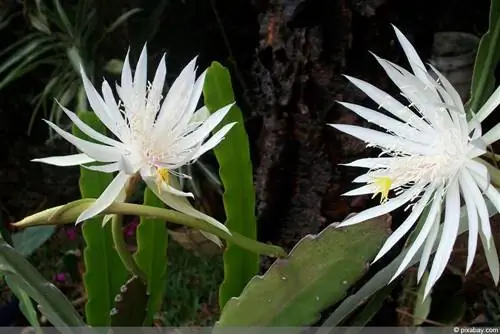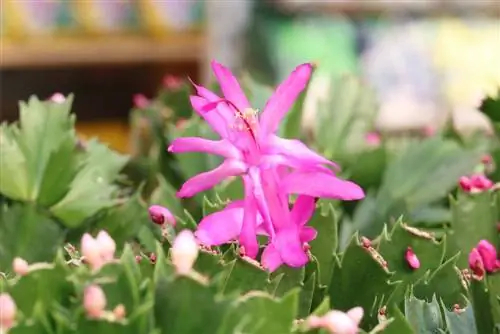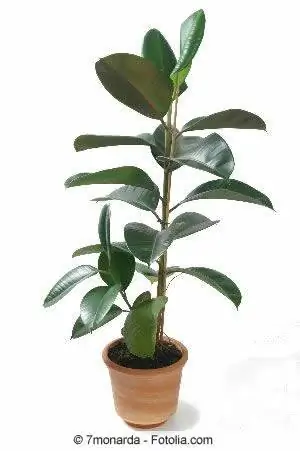- Author admin [email protected].
- Public 2023-12-17 03:39.
- Last modified 2025-06-01 06:48.
Leaf cactus, also called epiphyllum and phyllocactus, is one of the most beautiful cactus species. This plant is very popular because of its lush flowers in red, pink, purple or yellow and is also quite easy to care for. Important to know that leaf cacti require slightly different care than most succulents.
Popular houseplant
Leaf cacti do not come from desert regions like most succulents, but are at home in the tropical moist forests of the American continent. This origin also explains most of the differences in care. There are numerous cultivars and hybrids available on the market that differ in the shape and color of the flowers. Individual specimens even have flowers with an impressive diameter of approx. 30 cm. Finally, it should be mentioned that the popular Christmas cactus (Schlumbergera) is also a leaf cactus.
Location from spring to autumn
Epiphyllum, like most cacti and other succulents, needs a bright and warm location. Direct sunlight is harmful to the plant and can cause burns. A few hours of sun per day is not a problem. Waxed paper or light-colored cotton fabric, for example, attached to the window pane, serves as good sun protection. A leaf cactus that is allowed to stand outside during the warm season feels particularly comfortable. The same applies here: The location must be bright and without direct sun. The advantage of staying outdoors: UV rays are absorbed through the window glass, but cacti urgently need them for their growth.
The location should also be protected from rain, although these cactus plants in particular can tolerate more humidity than their desert relatives. The time to move the plants to their winter quarters comes before the first frost at the latest.
Tip:
Schlumbergera needs several hours of darkness every day to form buds and therefore feels comfortable on the windowsill in a room that is only slightly lit in the evenings in autumn and winter.
Wintering
Phyllocactus is not hardy, but needs a cool location in winter. If the plant grows in a warm room all year round, it will weaken it over time. A winter garden is suitable as winter accommodation, with temperatures of around 15°C. If a winter garden is not available, the leaf cactus can overwinter in a room that is only heated sparingly, e.g. in the bedroom. Even in winter, this plant needs sufficient light.
Substrate
Although Epiphyllum is a cactus plant, this plant does not need cactus soil. What's more: in the cactus soil, the plant threatens to die quickly. Ready-made mixtures for the leaf cactus can be found on the market, otherwise the conventional potting soil can be mixed with 1/3 lava gravel. A little peat also benefits the plants. The right substrate for this type of cactus should definitely be humic and at the same time loose and permeable to air.
Pouring
In contrast to many succulents, the leaf cactus prefers it to be moist. The plant can only tolerate drying out of the soil and thus the roots to a limited extent and can die quickly. It is essential to ensure good drainage, waterlogging is unhe althy for the epiphyllum. It is only watered with lime-free water; it is recommended to descale tap water or - even better! - Use rainwater. Water so much that the substrate always remains moist. The leaf cactus needs water all year round, but only a little water is needed in winter. Outside of winter, the leaf cactus should be sprayed daily with lukewarm water.
Tip:
Only spray if the plant is not exposed to direct sunlight - the plant can suffer serious burns!
Fertilize
In this respect, the leaf cactus also differs from most cacti and requires different fertilizers. Actually, a conventional flower fertilizer should be sufficient in an economical dosage, half of the recommended dose is sufficient. Fertilization is carried out approximately every two weeks and only from March to August. During the winter break, the plant does not need any fertilization because its metabolism is slowed down and it cannot absorb the fertilizer.
Tip:
The fertilizer must only contain a small amount of nitrogen, as this leads to the formation of rotten areas on the plant body.
Propagation
The easiest way to propagate is through cuttings, proceed as follows:
- Cut a shoot (“leaf”), approx. 15 cm long, from the epiphyllum,
- Wrap the cutting in a dry cloth and leave it to dry for about a week,
- As soon as the cut has dried out, place it in a loose sand mixture or a special leaf cactus mixture,
- Planting depth is about 2-3 cm,
- After another week or two, the cuttings have taken root and can be repotted.
Repotting
Young, fast-growing plants should be repotted annually. Repotting may occur less frequently with older plants. Experienced gardeners recommend changing the substrate once a year or every two years. To do this, the plant is carefully removed together with the ball of soil, the remaining substrate is disposed of and the new one is filled in.
Tip:
The Christmas cactus also has thorns, which are very difficult to remove from the skin! Do not work without gloves!
Diseases
Leaf cacti are undemanding houseplants and rarely get sick. Most he alth problems can be traced back to incorrect care. If phyllocactus gets too little light, thin, curled shoots quickly form. These must be removed and better lighting conditions must be provided. Calcified water can cause severe damage to the plant, and a lack of drainage is also unhe althy and causes the leaf cactus to rot - particularly dangerous due to root rot! On the other hand, it helps to repot in air-permeable soil and only water moderately. If the cactus is attacked by spider mites, then it is a sign that the air is too dry. In addition to chemical agents, regular spraying can help.
Frequently asked questions
Are leaf cacti suitable as hanging basket plants?
Yes, Schlumbergera in particular looks attractive as an ampelous plant. If Epiphyllum does not grow as an ampelous plant, older plants must be supported, otherwise the shoots risk breaking off.
Can leaf cacti overwinter outdoors?
If the winter is very mild and well protected, phyllocactus can overwinter outside, but temperatures below -3 °C damage the plant, so the optimal winter quarters are a winter garden.
What you should know about the leaf cactus in brief
- The leaf cactus has small shoot-like attachments, which are usually referred to as the leaves of the plant.
- Some cacti also have small spines, but they are soft and not piercing.
- The flowers of the leaf cactus reach a normal size of approx. 20 cm.
- The flower colors can be admired in white-yellow and red or orange, depending on the variety.
- The flowers themselves have a large number of leaves and there are raised pistils in the middle.
- The flowering period of the leaf cactus is usually from spring to summer.
- Since the cactus comes from the rainforests of South and Central America, it likes it warm and moist.
- However, he doesn't like direct sunlight and he finds temperatures of 20-25 °C to be most pleasant.
- Since the climate here is quite mild, the leaf cactus is also ideal as a balcony or terrace plant.
- It also accepts shady places, but in which it only grows slowly.
- The leaf cactus is not winter-proof, which means that in winter it needs a bright but cool place. 15-20 °C is sufficient.
- In winter the cactus doesn't need a lot of water, but you should still be careful that the soil doesn't dry out completely.
- It is poured from below. If you watered it from above, it would cause rot.
- The cactus likes a sandy substrate or cactus soil as fertilizer. You can also make the mixture yourself.






